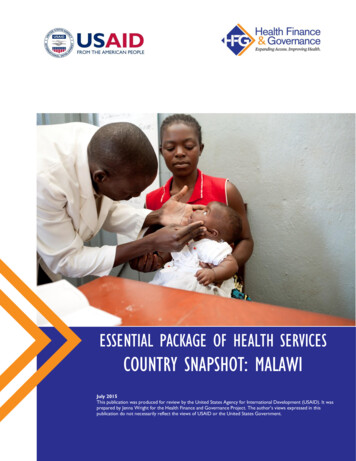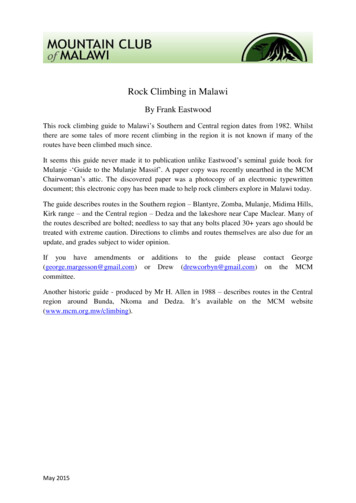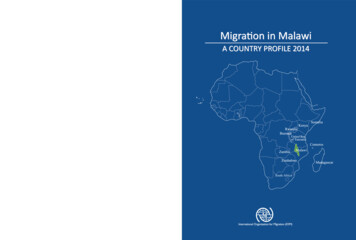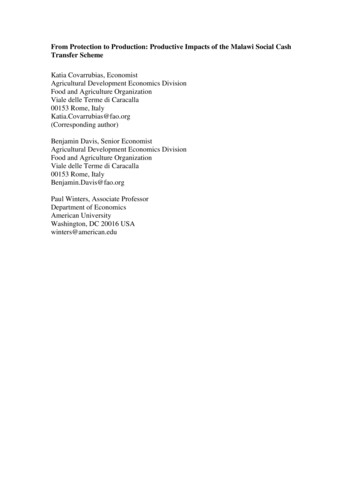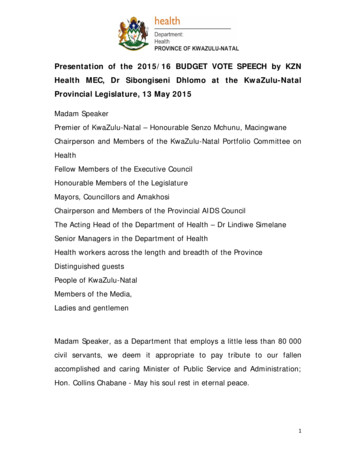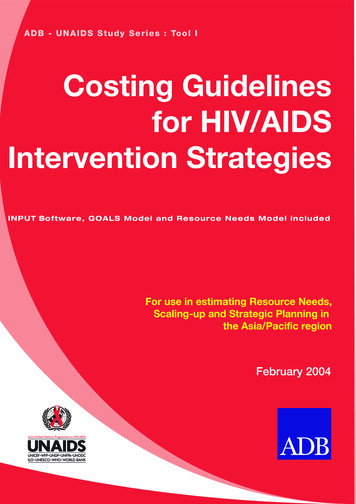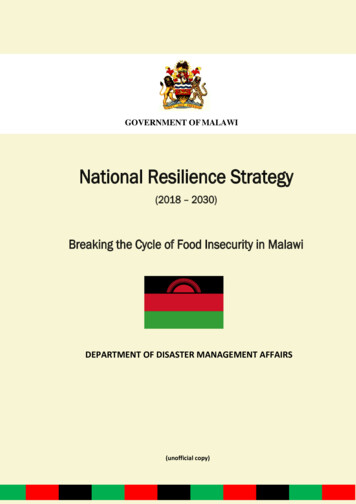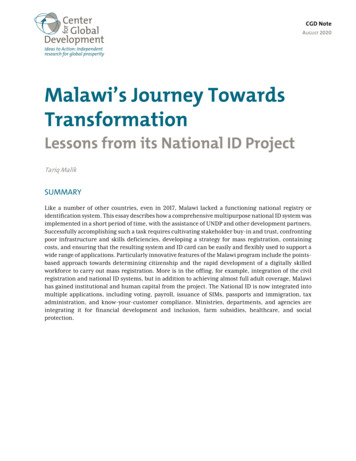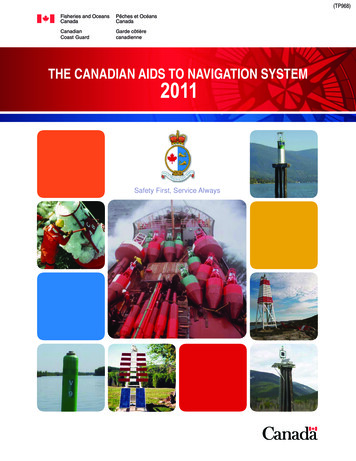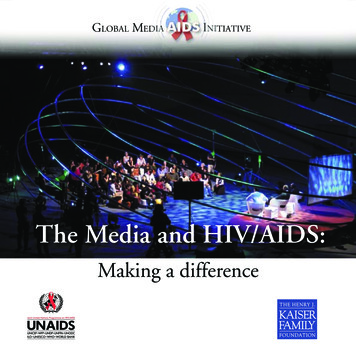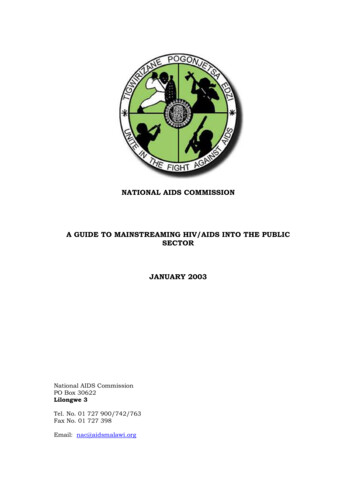
Transcription
NATIONAL AIDS COMMISSIONA GUIDE TO MAINSTREAMING HIV/AIDS INTO THE PUBLICSECTORJANUARY 2003National AIDS CommissionPO Box 30622Lilongwe 3Tel. No. 01 727 900/742/763Fax No. 01 727 398Email: nac@aidsmalawi.org
TABLE OF UCTIONiiiiii1CHAPTER 1WHY IS HIV/AIDS CRITICAL FOR MALAWI’S DEVELOPMENT?33INTRODUCTIONWHAT IS HIV/AIDS?WHAT IS THE LINK BETWEEN HIV/AIDS AND DEVELOPMENT?HIV/AIDS AND GENDERWHY IS HIV/AIDS CRITICAL FOR THE PUBLIC SECTOR?33456WHAT IS IN THIS GUIDE?WHO IS THE GUIDE FOR?HOW TO USE THE GUIDE?111CHAPTER 2WHAT IS MAINSTREAMING?INTRODUCTIONGENERAL GUIDELINESWHAT IS HIV/AIDS MAINSTREAMING?WHAT ARE THE OBJECTIVES OF MAINSTREAMING?CHAPTER 3HOW TO MAINSTREAM HIV/AIDS ISSUES AT THE WORKPLACEINTRODUCTIONSTEP 1: BECOME INFORMED ABOUT HIV/AIDSSTEP 2: TALK ABOUT SEX, STIS AND HIV/AIDSSTEP 3: ASSESS THE IMPACT OF HIV/AIDSSTEP 4: DEVELOP A STRATEGY TO REDUCE HIV INFECTIONS ANDSTEP 5:STEP 6:STEP 7:PREMATURE DEATHDEVELOP AN IMPLEMENTATION PLANIMPLEMENTATION AND MONITORINGEVALUATIONCHAPTER 4MAINSTREAMING AT THE CORE FUNCTIONAL TEP 1: UNDERSTANDING THE LINK BETWEEN YOUR CORE BUSINESS ANDYOUR CLIENTELE15STEP 2: SITUATION ANALYSIS15STEP 3: FORMULATE MITIGATION STRATEGIES TO RE-ORIENT YOUR COREBUSINESS TO PREVENT FURTHER HIV INFECTION AND IMPACT 16STEP 4: DEVELOP AN ACTION PLAN17STEP 5: IMPLEMENTATION AND MONITORING18STEP 6: EVALUATION18ANNEX 1: CHECKLISTANNEX 2: KEY EXAMPLES20221
ACKNOWLEDGEMENTThe National AIDS Commission is thankful and grateful for the advice and guidanceprovided by partners who participated in a workshop in May 2002 to review an earlierversion of the Mainstreaming Guide. Particular thanks to Dr. Grace Malindi and Dr.Agnes Chimbiri whose tireless efforts resulted in the booklet which you are readingtoday.We hope that this Guide will prove useful to all managers charged with developingand supervising HIV/AIDS mainstreaming programs in their departments andinstitutions. Feedback to the NAC Secretariat on what is particularly useful in thisGuide would be welcome.i
FOREWORDJustin MaleweziVice Presidentii
ACNGOPLWAUNAIDSUNDPSTITORVCTAcquired Immuno-Deficiency syndromeAntiretroviralCommunity based organizationDistrict AIDS Coordinating CommitteeInformation, Education CommunicationHuman Resource Management DevelopmentHuman Immuno-deficiency virusMalawi Institute of ManagementMalawi Poverty Reduction Strategy PaperMother to child transmissionNational AIDS CommissionNon-governmental OrganizationPerson living with AIDSThe Joint United Nations Programme on HIV/AIDSUnited Nations Development ProgrammeSexually transmitted infectionTerms of ReferenceVoluntary Counselling and Testingiii
INTRODUCTIONThis guide will assist Government Central and Line Ministries,Departments and Parastatals to develop sector specific responses tothe HIV/AIDS epidemic. It will guidepublic sector managers atvarious levels to mainstream HIV/AIDS issues into sectoral policies,programme planning and implementation processes within theworkplace and the institutional core business. HIV/AIDSmainstreaming refers to a process of making HIV/AIDS issues partand parcel of the way an institution organizes itself, threats its staffmembers and delivers its services.What is in this Guide?There are four main chapters progressively presented from acontextual and conceptual background to a framework of guidelines tofacilitate the process of mainstreaming.Chapter 1 is a discussion of the HIV/AIDS situation, the nationalresponse to the epidemic and the links between HIV/AIDS, sectoraland national productivity and household poverty.Chapter 2 presents a conceptual framework for what constitutesmainstreaming in the public sector.Chapter 3 is a discussion of the process of creating awareness anddialogue in the workplace, while Chapter 4 deals with the linksbetween an organization’s core business and its clientele. Bothchapters cover HIV/AIDS impact assessment, strategy formulation,implementation planning, and monitoring and evaluation.The annexes provide some helpful checklists and examples.Who is the Guide for?The mainstreaming guide is for all Principal Secretaries, Directors,and middle managers in Central and line Ministries and Parastatals.This guide may also be useful to individuals or groups facilitatingmainstreaming HIV/AIDS issues into their respective public sectorcore business such as: HIV/AIDS sector focal points, task forces,organizing committees, local experts and consultants working withinthe public sector.How to use the Guide?Central Ministries- This guide will help central Government bodies todevelop appropriate policies and procedures that line agencies can useto reduce HIV/AIDS impact in the workplace and their core business.1
Line Ministries - As focal points for public service delivery, lineagencies will use this guide to develop strategies and action plans toreduce risks of HIV/AIDS transmission in the work place and thesurrounding communities and to reduce the impact of HIV/AIDS onstaff members’ performance and institutional productivity.Parastatals - The guide will help managers of parastatals developstrategies and action plans in order to reduce HIV/AIDS risks andfocus on improving institutional productivity and performance.2
CHAPTER 1WHY IS HIV/AIDS CRITICAL FOR MALAWI’S DEVELOPMENT?IntroductionAt the end of 2001, globally, an estimated 40 million people wereliving with HIV. In many parts of the developing world, the majority ofnew infections occur in young women who are especially vulnerable.About one third of those currently living with HIV/AIDS are aged 1524. Most of them do not know they carry the virus. Many moremillions know nothing or too little about HIV to protect themselves.The Sub Saharan Africa that contributes to only 10% of the totalworld population is home to almost 70% of people infected withHIV/AIDS.Malawi has not been spared. It is estimated that 15 percent of thepopulation between 15 and 49 years of age are HIV positive. Youngwomen are 4 to 6 times more likely to be infected than their malecounterparts. Numbers of orphans and widows are increasing. Thecumulative number of orphans was estimated to be 10,000 in 1990and 360,000 in 2002 (NSO,1990). National AIDS Commission (2000)estimates that over 70,000 orphans will be added annually as thenumber of AIDS deaths increases during the decade and beyond.The first case of HIV/AIDS was reported in Malawi in 1985. Sincethen, the number of reported HIV/AIDS cases has reached suchepidemic proportions that it is hard to find a Malawian who has notbeen affected by the epidemic. It is therefore high time that Malawi asa nation scaled up efforts to prevent further spread of HIV/AIDS andreduce its impact in the workplace as well as the surroundingcommunities.In response to the alarming trends of the epidemic and its impact, theGovernment of Malawi in partnership with civil society developed aNational HIV/AIDS Strategic Framework (2000 – 2004) to guide thenational response. The NSF identified HIV/AIDS mainstreaming inthe public and private sectors as one of the key strategies foraddressing and scaling up the national response to the epidemic.What is HIV/AIDS?HIV and AIDS are two different things. HIV causes AIDS, but a personmay be HIV positive without having AIDS.HIV (Human Immunodeficiency Virus) is a virus that attacks whiteblood cells and causes a breakdown in the body’s immune system,making it susceptible to infection. HIV does not immediately causesickness itself, but makes it easier for a person to become sick from3
other diseases. Thus a person who has contracted HIV may be healthyand productive for a long time. However, he/she is likely to becomesick more often than he/she would be without the virus.HIV is spread through having unprotected sexual intercourse with aninfected person (this is the cause of 90 % of transmission in Malawi); amother passing the infection on to her child during pregnancy,delivery or breastfeeding (9 % of transmission); being in contact withinfected blood or blood products (e.g. through blood transfusions,injections with unsterilized needles, razors and knives).AIDS (Acquired Immune Deficiency Syndrome) occurs when HIV hasaffected the body’s immune system to such an extent that it is tooweak to fight against every day types of bacteria, parasites and virusesthat we are all surrounded by. It leads to a wide range ofOpportunistic Infections (OIs ), which usually include some of thefollowing: Persistent cough Tuberculosis (TB) Skin rashes Loss of body weight Chronic diarrhoea Lip and gum ulcers Fever (prolonged or intermittent) Skin cancer HIV dementia PneumoniaWhat is the link between HIV/AIDS and development?HIV/AIDS is indeed a development issue. This is because HIV is achronic condition affecting both the short and long term economicstability of households. In the short term, it makes households newlypoor or pushes them further into poverty by diverting householdinvestments, savings, and current income into care and support forthe chronically ill. Time available for work also shrinks as adults fallsick, care for loved ones, or attend funerals frequently.In the long term, income earners may lose their jobs or die, leavingyoung orphans who may not be able to attend school and may notreceive sufficient support to have proper nutrition. In the absence of aguardian, these young orphans may drop out of school in order to findwage employment for their survival and that of their siblings.Population count of 1998 shows that half of the population of Malawicomprises young people aged 15 years (4,370,902) and the elderlyaged 65 and above (397,355). These are the population segmentswhose survival depend on the other half of the population. An increasein the number of adult deaths and young orphans will result into4
negative growth in the country’s economy and a decrease in thegrowth of per capita income.The Malawi Poverty Reduction Strategy Paper (MPRSP) recognizesthese development linkages and identifies HIV/AIDS as a cross cuttingissue to be addressed in all development efforts. It is thereforeimportant that public sector managers and staff see the connectionbetween national development issues and the epidemic, and are ableto identify which challenges facing their respective sectors are linkedto HIV/AIDS. Public sector managers also need to assess the ways inwhich the public sector unintentionally contributes to the spread ofthe epidemic and in turn, is affected by it.HIV/AIDS and GenderHIV/AIDS raises a number of gender issues in the Malawi context.The primary mode of transmission (heterosexual sexual relations1)affects women disproportionately, due to biological and social factors.The economic dependence of girls and women increases thisvulnerability, exposing them to higher risk of HIV infection. Biologically, women’s bodies are more vulnerable to infection, whilemale semen has a higher concentration of the HIV virus than dofemale secretions.Socially, women and girls are more vulnerable because customarylaws encourage child marriages, polygamy and multiple sexualpartners, while the predominant social system2 does not recognizea woman’s right to make independent decisions about sex or childbearing.Economically, many women and girls are disadvantaged, whichleads them to engage in sexual activities that are exchanged formoney or favours.Lastly, women are shouldering most of the burdens that come withthe epidemic (care of the sick, time spent on funeral activities).This situation results from processes of socialization, economicimplications of social norms and values, and unequal power relationsbetween the sexes (men/women; men/girls; boys/girls; women/boys).Public sector managers need to understand these power relations andattitudes among their staff and be aware of how they contribute to theescalation of the epidemic.1This is a term used to refer to sexual activity between men and women.2A social system refers to institutional structures (traditional, Government and private), whichdetermine the roles and functions of individuals and segments of the institution.5
Why is HIV/AIDS critical for the public sector?The public sector is the largest service provider in the country. Itsfunctioning depends on the efficiency and productivity of itsworkforce. However, the HIV/AIDS epidemic is having a profoundsocial and economic impact on public sector operations. Prolongedillnesses, increased absenteeism and deaths of staff that cannot beeasily replaced are slowly crippling institutional productivity.Increased funeral expenses, premature employee benefits, continuousrecruitment and training are absorbing funds that could have beenspent on programs and services. As a result of these impacts, theGovernment is having difficulty coping with new and substantialdemands on the already scarce public resources.Recognizing the important role that the public sector plays in thecountry’s economy and as an employer, a workshop was organized inJune 2000 to enable the various sectors to initiate HIV/AIDSmainstreaming efforts into their core business. Since then, a numberof public institutions have developed workplace policies andprogrammes on HIV/AIDS. However, coverage is quite incomplete, soin financial year 2002/2003, the Government introduced a budget lineto finance HIV/AIDS activities in the workplace. This booklet isintended to facilitate the task of public sector managers facing thechallenge of developing and implementing HIV/AIDS work placeprograms for the first time.6
CHAPTER 2WHAT IS MAINSTREAMING?IntroductionThis chapter provides general principles for mainstreaming HIV/AIDSinto the public sector. These principles form the basis for developinga relevant and harmonized public sector response to the epidemic.Different organizations and actors at different positions of influencewill have different concerns, responses, needs and priorities. Thistherefore calls for guidelines at various management and operationallevels.General GuidelinesPublic servants cannot afford to ignore HIV/AIDS. They need todevelop sector strategies, policies, procedures, implementation plansand monitoring/evaluation systems in order to manage the problem ofHIV/AIDS within the workplace and the communities that they serve.In developing mainstreaming plans, managers and staff need to thinkabout sector comparative advantage and complementarities of rolesbetween service providers and their clients. Key building blocks for amainstreaming program would include: Strategies that provide an overall framework for action.Policies that provide guidelines and direction for theimplementation of actions.Procedures that tell staff members how to enact the policiesImplementation Plans that map out the actions and proceduresbased on availability of resources such as time, funds andpersonnel.Monitoring and evaluation system that provides feedback on anyneed for changes to policies and procedures.What is HIV/AIDS Mainstreaming?Mainstreaming is a strategic process of making HIV/AIDS issues partand parcel of the way an institution organizes itself, treats its staffmembers, and delivers its services. In developing HIV/AIDS workplace and client-oriented programs, it is important to keep in mind thefirst golden rule of mainstreaming: Mainstreaming of HIV/AIDSshould take place without losing focus of the core business.One can think of the mainstreaming process as being composed ofvarious stages, which build upon each other:7
MAINSTREAMING STAGES Identification- assessing the current situation in order to identifyprimary HIV/AIDS concerns, issues and needs.Internalisation- getting convinced and committed to deal with deeperand complicated issues of HIV/AIDS.Integration- making HIV/AIDS issues part of the sector policies, plans,and programs.Institutionalisation- enhancing and scaling up HIV/AIDS integrationefforts, targeting key categories of staff and client groups.The important thing in the process of mainstreaming is to ensure thatthese stages are translated effectively into action:MAINSTREAMING ACTIONS Policies- guidelines for implementation of identified strategies andactions to combat HIV/AIDS in the workplace and core businessPlans- outlines of the way HIV/AIDS policies and procedures will beimplementedPrograms- HIV/AIDS-related activities with an allocation of budget andother resources (time, materials and personnel).Partnerships- builds relationships with key stakeholders in the area ofHIV/AIDS and your core business.What are the objectives of mainstreaming?HIV/AIDS mainstreaming in the public sector aims at: Providing staff members, managers and communities thatorganizations serve sufficient and up-to-date information to enablethem to protect themselves from infection and mitigate the adverseimpact with emphasis on behavioural change interventions. Promoting the use of participatory analytical tools for bringing outcrucial and deeper HIV/AIDS issues, concerns, needs and prioritiesto be mainstreamed into ongoing activities at the workplace and inthe core business. Identifying ways in which core business activities can be reorganized, re-oriented and carried out differently in order to reducefurther transmission of HIV.8
Promoting appropriate and effective ways of managing HIV/AIDSepidemic and opportunistic infections in the workplace andsurrounding communities.Building a supportive environment that would reduce stigmatisationand discrimination for those who are already infected or affected.Providing managers and program facilitators with tools that theymay utilize to develop human resource success plans in response tothe epidemic.9
CHAPTER 3HOW TO MAINSTREAM HIV/AIDS ISSUES AT THE WORKPLACEIntroductionAt the workplace level, there are four key steps that organizations canfollow to reduce the impact of HIV/AIDS on the productivity of staffmembers and to increase the response of communities to socialservice provision. In taking these steps, all staff should always respectthe workplace golden rules:General Principles - Golden Rules Step 1:Staff members with HIV/AIDS should be treated the sameas any other staff memberThe needs of the manager should be balanced with theneeds of the staff membersManagers should consult the SADC and ILO codes ofpractice and conduct when in doubtBecome Informed about HIV/AIDSInformation is power. If people are to be empowered to make informeddecisions, they need information. Information reduces stigma, andfacilitates discussion about HIV/AIDS and the means for prevention.There are many sources of information about HIV/AIDS. Some of themore well-known, established organizations who provide informationon HIV/AIDS prevention include: Banja la Mtsogolo (BLM), MalawiAIDS Counselling and Research Organization (MACRO), Lighthouse,Population Services International (PSI) and hospital VCT centres.As managers and facilitators in your organization, make sure that youunderstand what HIV is, how it is transmitted and how it may beprevented. Know how AIDS may affect people as the diseaseprogresses. This knowledge will help you be informed about what toexpect when your staff members and clients become infected.Managers, staff members and communities should have accurateinformation on HIV/AIDS prevention, mitigation, care and support.Step 2:Talk about Sex, STIs and HIV/AIDSIn Malawi, there is a taboo that does not encourage workplace orcommunity dialogue about Sex and Reproductive Health. People say;‘It is not Malawian culture to talk about sex’. But if not protected, the10
Malawian culture will disappear because the nation will die. We needto keep in mind that culture changes with time. People’s values canchange when faced with such a threat as AIDS. We need to be open tochange in order to protect our children and grand children’s future.In order to bring a human face and voice to HIV/AIDS at the workplace invite PLWA through MANET and NAPHAM to take part in workplace HIV/AIDS education and counselling sessions. Through sharingtheir experiences, PLWA break the silent culture, stigma, denial anddiscrimination associated with HIV/AIDS. They may also assist inorganizing awareness sessions such as talks and distribution of toolsof engagement: question boxes, response/notice boards, newsletters,drama etc.Step 3:Assess the impact of HIV/AIDSIn order to design HIV/AIDS related interventions that are fullyresponsive to your institution’s needs, it is desirable to find out asmuch as possible about the extent to which HIV/AIDS is alreadyaffecting your staff and their families. Well targeted data collectionefforts also enable institutions to identify and address capacity gapsrelated to attrition caused by AIDS-related illnesses and deaths. Dataare needed on: (i) basic population; (ii) morbidity/mortality; (iii) workplace impacts; (iv) perceived needs/areas of interest:(i) population Number of staff members per cost centre -, disaggregated bylocation, skill category, grade, sex and age. Number of dependents(ii) morbidity/mortality Seroprevalence rates (anonymous surveys to maintain staffprivacy/confidentiality) Recorded absences from the job -and reasons for absenteeism Number of chronically ill staff members Number of staff requesting disability / early retirement Number of employee deaths per year Number of funerals attended per week.(iii) work place impacts Number of vacancies (overall, per location, per skill category,etc) Recruitment requirements per year (replacements & promotions) Training needs for new recruits and replacements Recruitment costs Training costs Costs of funerals / terminal benefits Changes in staff morale11
Perceptions of HIV-positive staff and those with full-blown AIDS.(iv) access to / interest in HIV-related supportNumber of staff accessing HIV/AIDS-related services and type ofservices being accessed.Level of demand for selected services (eg. condoms, home basedcare packages during illnesses and deaths, VCT, ARV).Resources available for HIV work place programsResources available for employee benefitsNumber of staff trained in peer education & counsellingBaseline surveys on knowledge, attitude, perceptions, and behaviouramong staff are also useful for measuring progress during workplaceprogram implementation.Armed with information about institutional capacity gaps, knowledgeand attitudes among staff, and levels of demand for services/financialassistance, managers and staff will be better prepared to developworkplace programs that meet staff needs and to create anenvironment that facilitates the performance of staff members withHIV/AIDS as well as those not yet infected.Step 4:Develop a strategy to reduce HIV infections andpremature deathOrganizations should develop strategies to minimize disruptions towork activities, since leaving posts vacant or replacing skilled workerswith unskilled is not usually satisfactory.One option thatorganisations employ is to ensure that personnel are multi-skilled andcan perform a range of functions. Another tactic is to develop asuccession plan which maps out which skilled personnel mayeventually require replacement, and plans for recruitment orpromotion in advance or for grooming colleagues for handover. Forsuccession planning to be effective, institutions need to address anumber of personnel issues (recruitment, training, promotion,dismissal, risk management, worker’s compensation, occupationalbenefits).Apart from planning for the replacement of chronically ill personnel,managers and staff will also wish to develop HIV/AIDS awareness andbehaviour change programmes in order to reduce new infectionsamong the work force and their dependents. Implementation of suchactivities may rely on trained personnel from within an organization,on PLWA staff members (if willing), or on external facilitators (eg, fromassociations like NAPHAM or specialised NGOs). In-house PLWAs arewell placed to share their experience and educate co-workers on howto change their sexual behaviours and therefore reduce the risk ofbeing infected. Work place prevention programs may include VCT,depending on availability of skilled personnel.12
Lastly, if funding is available, managers may consider including careand support programs for their staff, up to and including ARVtreatment. HIV positive staff members can and do live long lives. Ittakes about ten years before HIV infected persons develop full-blownAIDS. If the infected have good nutrition and continuously seekmedical attention for opportunistic infections and health care andsupport, they can extend their productive lifetime and remain effectivein their performance. Sustainability of care and support costs, andequity issues related to access to treatment have to be addressedwhen developing workplace HIV/AIDS programs.Step 5:Develop an Implementation PlanIn order to lay a solid foundation for effective implementation ofstrategies and action plans, some pre-implementation steps areimportant and can make all the difference: Appoint a focal pointIdentify an individual who is experienced and respected within theorganization to take responsibility for ensuring that policies andprocedures relating to HIV/AIDS are implemented. Make resources availableYou will need a budget to disseminate new policies, increasetraining opportunities, communicate behaviour change messages,etc. Office space and trained personnel will be required forHIV/AIDS education and counselling, training of peer educators,sensitisation meetings and talks. Transport for implementation isalso key in order to reach staff working in different locations. Draw up an implementation planA detailed work plan with indications of estimated time,responsible persons/key partners, expected output and specificbudget for each activity, should be drawn up in a participatorymanner in order to ensure effective implementation. Provide leadership from the topIf public sector managers are open to talk about HIV/AIDS-relatedissues, the rest of the staff will find it easier to do the same. Thebest leadership is by example. Be a good role model to your staffby being pro-active on issues related to HIV/AIDS and an advocateof change in sexual behaviour.Step 6:Implementation and MonitoringMonitoring takes place throughout the process of implementation.Each activity should be monitored to check if what was planned hastaken place within the scheduled time and budget. Monitoring will13
also reveal whether the proposed strategies were appropriate or not.Find out from your staff members: Are workplace policies and procedures being implemented asintended?If not, what seems to be the problem?What do they think about the HIV/AIDS activities in the workplace?Do they think that they are appropriate? Effective ?If they think they are not appropriate or effective, what change dothey propose?Etc. Step 7:EvaluationEvaluation indicates whether the expected outcomes of workplaceactivities were achieved or not. Evaluation is conducted through rapidsurveys and impact assessments. Comparison with data collectedduring baseline surveys will indicate whether progress is being made /trends are changing. Examples of questions you may ask mightinclude: Are the concerns of infected staff members addressed?Is there a success plan?How many staff members have multiple skills?Are work place policies and procedures having the desired impacton the workforce?How many managers and planners have a leadership role in thework place activities?Do your recruitment, promotion, training, grievance andoccupational procedures take into account the needs of infectedstaff members?14
CHAPTER 4MAINSTREAMING AT THE CORE FUNCTIONAL LEVELIntroductionThis chapter takes you through the process of mainstreamingHIV/AIDS in the core business of your organization. As definedearlier, core business refers to the purpose and overarching goal forwhich the institution was created. This may further be broken downinto core functions, which refers to key activities and relatedresponsibilities specific to achievement of the institutional goals.Similar to the process of mainstreaming HIV/AIDS at the workplace,the process mainstreaming HIV/AIDS at the core function level oforganisations has six steps. During this process, it is important tomatch your product or service provision with your clients needs takinginto consideration the context of HIV/AIDS issues, concerns, needsand priorities.Step 1:Understanding the link between your core businessand your clienteleIn order to start the process of mainstreaming HIV/AIDS issues intoyour core business, you as the manager or the HIV/AIDS focal point,will need to focus on the following pertinent key questions: What is your core business?What are your core functions?Who are your clients?What are the levels of HIV/AIDS knowledge, attitude and practiceamong managers and staff members?What are the levels of HIV/AIDS knowledge, attitude and practiceamong your clients?How does your organization interact with clients?Step 2:Situation AnalysisIn order to focus on mitigation strategies and activities, you will needto assess a number of factors: how HIV/AIDS is affecting your corebusiness, how your core business might be promoting HIV acquisitionand transmission, and what is your in-house capacity to implementHIV/AIDS impact mitigation strategies. The process of assessing thisimpact would involve participatory collection and analysis ofinformation.To better understand HIV/AIDS impacts and transmission factors,key questions to ask include the following: How does your core business predispose you the manager, your staffmembers and clients to HIV and other opportunistic infections.15
How can your operational system prevent the transmission of HIV toyour staff members and clients? How would your core business become the vehicle for HIV/AIDSBehaviour C
The mainstreaming guide is for all Principal Secretaries, Directors, and middle managers in Central and line Ministries and Parastatals. This guide may also be useful to individuals or groups facilitating mainstreaming HIV/AIDS issues into their respective public sector core business such as: HIV/AIDS sector focal points, task forces,
